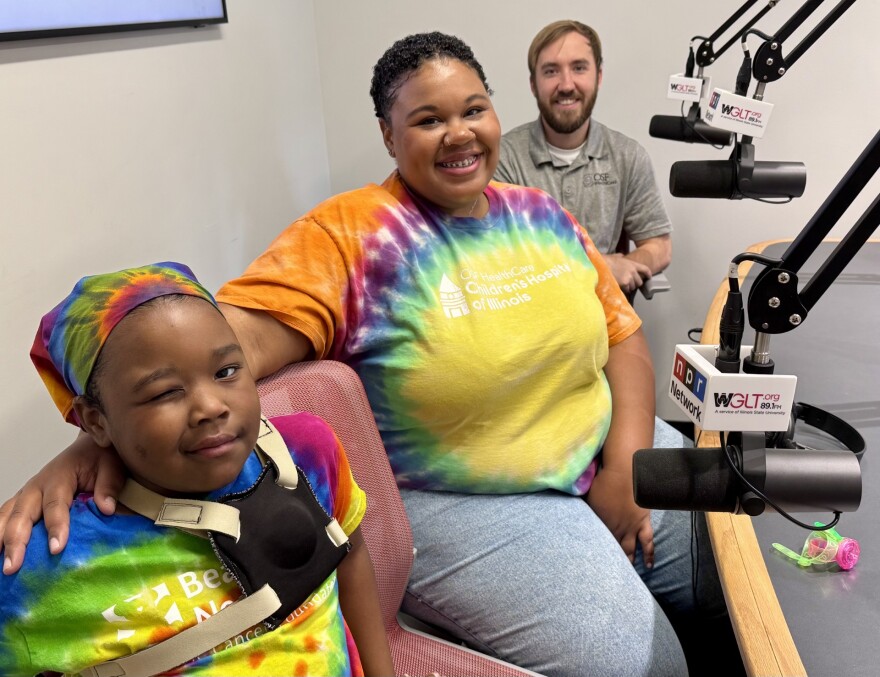Seven-year-old Amaneigh Stevenson of Bloomington is a second-grader at Bent Elementary. She likes gymnastics and arts and crafts. Her favorite subject is math.
But asked who she is, she said, “That’s a complicated question.”
Fair point. It is complicated.
“Amaneigh’s amazing,” said Karisma Morris-Bush, her mom. “She’s an awesome kid. She’s very strong, very wise — like my mini-bestie."
Learning Amaneigh had Hodgkin's lymphoma turned their world upside down.
“Obviously, I had to be supportive of Amaneigh,” said her mom, but that meant tough conversations with her sons, too.
“My sons had to adjust to not spending as much time with me,” she said. “We had to look to our community as a support system, because there was no way I was going to be able to do this on my own.”
Fear and anxiety were around every corner, beyond the main stress of a cancer diagnosis. Stevenson had a central venous port implanted in her chest. While that means less pokes and prods, it also meant one more thing to worry about.
“They would tell you, if it gets removed, she can get sick,” said Morris-Bush. “There were all these guidelines behind taking care of it on top of all the other things you have to worry about."
“It’s under the skin, but it’s very sensitive,” said Nick Kemp, Amaneigh’s exercise physiologist at the Heller Center for Kids with Cancer in Peoria, a division of OSF Healthcare. “Any types of bumps in that area cause kids to be reserved of more cautious.”
For Amaneigh, that meant cutting back on activities like gymnastics, plus all the physical activity that comes with being a kid.
“I could not be on bouncy houses and stuff,” she said. “All the stuff I couldn’t do, I really liked to do.”
Finding a solution
Kemp's job is to encourage children undergoing cancer treatment to stay active. When kids and parents said they worried about bumping their chest ports, he started researching ways to guard the site from impact.
“There weren’t any products out there on the market that were fully covering [the port], fully protecting it,” he said. “So, I knew that I had to create something that would."
Amaneigh tested a prototype of Kemp's port guard, developed with OSF's Innovation Center team. Morris-Bush said she didn't hesitate to have her daughter test drive the product.
“I have a very active daughter who’s been in gymnastics since she was 3,” she said. “When she was 1, she was jumping off dressers onto the bed. And having brothers. I had to explain to them, all the roughhousing — you guys can’t do that anymore."
A hard plastic shell covering the port is designed to withstand up to 70-mph impact, housed within a neoprene casing and worn sort of like body armor, with Velcro straps looped over the patient's shoulder. Kemp is now testing the product in other clinics and has obtained a patent. He's still refining the design based on feedback from families, making sure the port guard both stays in place, and is comfortable for kids.
“It’s been a really wonderful journey,” Kemp said. “Working with Amaneigh and getting the feedback that she gave to us has been great. Just seeing the return to activity, that’s ultimately what my goal is.”
Amaneigh has finished her treatment, and her chest port has been removed. For Morris-Bush, her daughter’s brush with cancer gave her and her children a chance to build a new relationship with the diagnosis.
“I lost my mother to cancer,” Morris-Bush said. “I never had a mother to ask these questions about being a mother. So, of course when I heard, I was just like, wow, again? It was already traumatizing having experienced that once. And then having to experience it with my own child? Instead of the end-of-the-road-type sentence, it’s not.”


